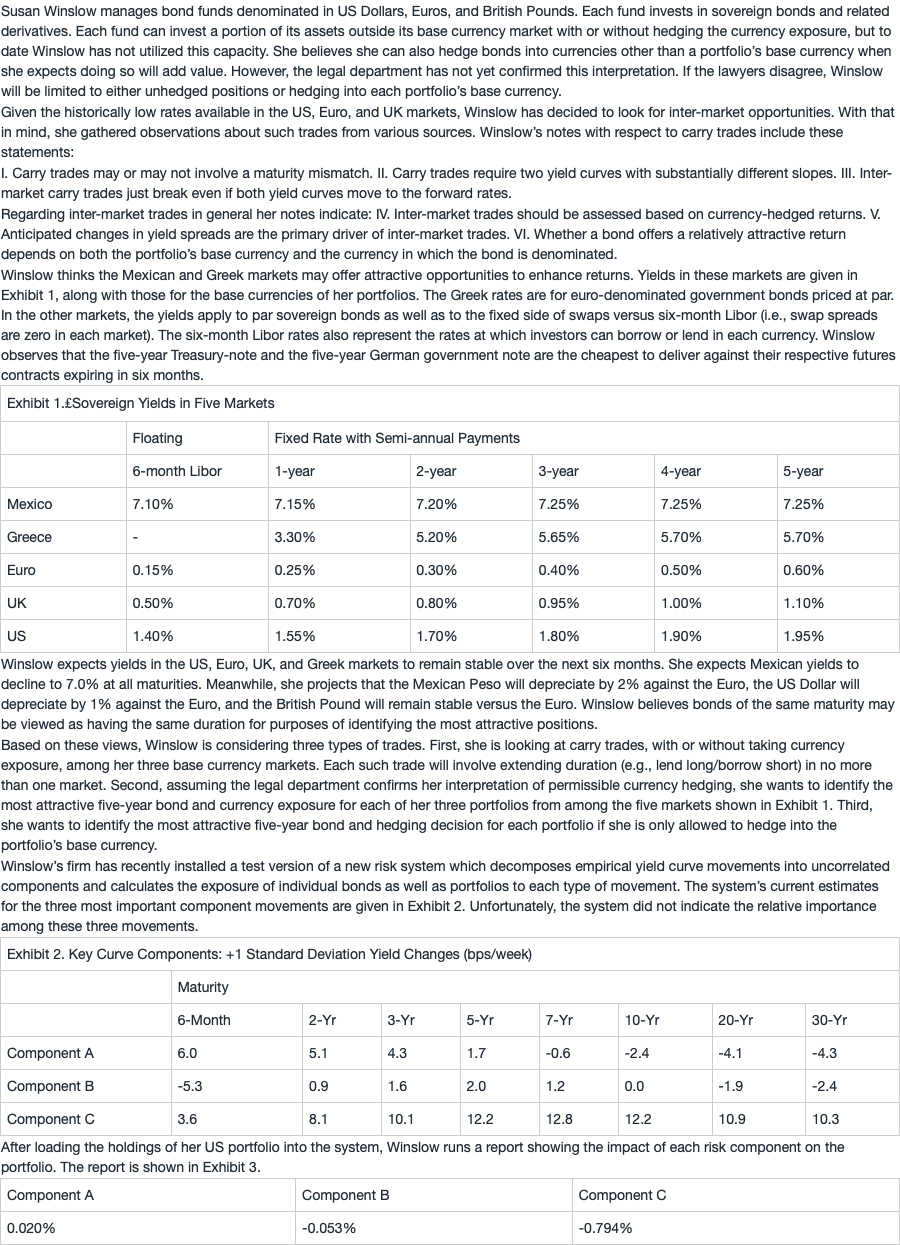嗨,努力学习的PZer你好:
先解释答案里的这句话,这句话是正确的:
Intra-market trades will break even if the curve goes to the forward rates because, by construction of the forward rates, all points on the curve will earn the "first-period" rate (that is, the rate for the holding period being considered).
他是说,在一国内部,如果未来的收益率曲线实现了期初Forward rate预测的利率,那么无论是多长期限的债券,只要投资期一致,那么他们实现的收益率相等。
那这样的话, Intra-market carry trade,借短期、投长期,借款实际利率和投资实际收益是相等的,那么这个策略实现盈亏平衡。
因为借短期和投长期,他们的投资期一致,实现的收益率相等,所以投资的收益与借款的利率一致,实现盈亏平衡。
这也就是为什么,在做carry trade时,我们要求收益率曲线是Stable,因为Stable代表着收益率曲线今天长啥样,明天还长这样。
明天的收益率曲线和今天的收益率曲线一样,那说明,明天的收益率曲线一定没有实现期初Implied Forward rate的预期。
因为如果收益率曲线向上倾斜,在期初,Implied Forward rate曲线一定比Spot rate曲线更高,如果明天实现了期初的Forward rate,那么明天的Spot rate一定比今天的Spot rate更高,这就不是Stable表述的意思了。
所以Carry trade要盈利,就代表预期未来的收益率曲线一定不会实现期初Forward rate的预期。如果未来的收益率曲线实现了期初Forward rate的预期,那么Carry trade恰好盈亏平衡。
Intra-market carry trades just break even if yield curve moves to forward rates
关于这个结论,其实是来自2级的一个结论:
If forward rates are realized, then all bonds, regardless of maturity, will have the same one-period realized return, which is the first-period spot rate.
也就是说,如果未来的收益率曲线实现了期初的implied forward rates,那所有的债券投资,无论是什么期限的债券,只要他们的投资期一致,那这个投资期实现的收益率就是这段时间的Spot rate(first-period spot rate)。
下面做一个简单的证明,假设:
1-year spot rate = 2%
2-year spot rate = 3%
3-year spot rate = 4%
这个Spot rate隐含的forward rate为:
f(1,1) = 4.01%
f(1,2) = 5.015%
假设一年过去了,利率实现了期初Spot rate隐含的Forward rate,即站在1年后的时间点看,one-year spot rate = 4.01%;2-year spot rate = 5.015%;
我们投资一个1-year zero-coupon bond,那实现的收益就是1-year spot rate = 2%,因为到期100,期初定价是2%定的,所以实现2%的收益率。
假设我们投资的是一个2-year zero-coupon bond,投资这一年实现的收益率计算为:
期初买债券的价格:100/(1+3%)^2=94.26
1年过去后,这支2年期债券变成了1年期债券,如果利率实现了期初的Implied forward rate,那未来1年期利率为:4.01%;按照新的Spot rate定价卖出债券的价格为:
100/(1+4.01%)=96.145
所以投资一年的收益率为:(96.145-94.26)/(94.26)=1.9998%,考虑计算的时候是近似的,所以理论值应该是2%
这样发现,如果收益率曲线实现了期初Spot rate隐含的Implied forward rate,投资1年期债券的收益是2%,投资2年的期债券的收益也是2%。这一年实现的投资收益率一样,都是第一期的Spot rate 2%。
同理,如果我们投资的是3年期的债券,期初价格为:100/(1+4%)^3=88.90
1年的投资期,1年后这支债券变成了2年期ZCB,如果利率实现了期初的Implied forward rate,那新的两年期利率是5.015%,那期末债券的卖出价格为:
100/(1+5.015%)^2=90.68
所以这一年的投资收益为:(90.68 - 88.90)/88.90 = 2%
发现投资3年期债券1年,实现的收益率也是2%。
这就说明,只要未来的利率曲线实现了期初预测的Forward rate,那么无论债券自身的Maturity是多少,只要投资期相等,他们实现的收益率就相等、且实现的收益率就是对应期限的Spot rate。
因为Carry trade是借短期利率、投长期利率,在这个期间内实现利差。
而如果利率实现了期初Spot rate隐含的Implied forward rate,那么无论是何种期限的债券,期间实现的投资收益率都一样,都是对应期限的Spot rate,那这样的话,在这个投资期内,Carry trade即便是借短期、投长期,借钱的实际利率和投资实现的收益,都是对应期限的Spot rate,那就刚好盈亏平衡。
比如,我们借1年期、投资3年期,从上面的计算可以看到,未来的利率如果实现了期初Implied forward rates,那借钱(1年期)的成本是2%,投资3年期债券1年实现的收益也是2%。这样,借钱的成本等于投资的收益,一国内部的Carry trade实现盈亏平衡。
所以做Intra-market Carry trade的投资者都是认为将来实现的利率不等于期初Spot rate隐含的Implied forward rate。
回忆Carry trade的收益率预测是Stable,收益率曲线今天长啥样明天还是啥样,所以按Stable的要求,明年的1-year spot rate应该还是2%,2-year还是3%,显然没有实现期初预测的4.01%与5.015%,这样其实Stable也是说利率没有实现期初的Implied forward rate。
选项C是想把上面Intra-market的那个结论引申到Inter-market carry trade。在Inter-market carry trade里,这个结论不成立。C选项说的不成立:
Inter-market carry trades just break even if both yield curves move to the forward rates.
也就是对于跨国的Carry trade,即便Yield curve实现了期初Forward rates的预测,这种Carry trade也不一定会Break even。
首先对于Inter-market carry trade,即便两国的利率曲线都实现了期初预测的Implied forward rate也无所谓。
因为是两个市场,大家的收益率曲线不一样,都有各自市场内部的First-period spot rate,first-period rate也不一样相等。
比如,A国的1年期利率是2%,B国1年期利率是5%,即便两国的利率曲线都实现了期初的Implied forward rate,那借A国1年期实际的借款利率是1年期的Spot rate 2%,投资B国实际实现的投资收益是1年期的Spot rate 5%,所以即便两国都实现了期初的Implied forward rate也无所谓,2%与5%的借贷息差依然存在。这点和Intra-market carry trade不同,因为Intra-market carry trade,一旦未来的利率实现了期初的Implied forward rate,借钱、投资的实际利率都是对应期限的Spot rate,因为是一国内部,Spot rate相等,所以盈亏平衡。而两个市场上First-period spot rate不一定相等,所以借钱利率和投资收益不一定相等。所以Carry trade不一定会Breakeven。
第二点就是即便两国的First-period rate相等,也就是两国对应的Spot rate都假设是2%,但是因为两国之间的Carry trade还涉及汇率的变动,所以Carry trade也不一定Breakeven。
所以C选项是把Intra-market成立的结论想推广到Inter-market carry trade。这个推广一定不成立。所以C选项错误。
但是C选项这句话改成一国内部是正确:
"Intra-market carry trades just break even if both yield curves move to the forward rates"
考试的话记住这句话的结论即可。
-------------------------------就算太阳没有迎着我们而来,我们正在朝着它而去,加油!




